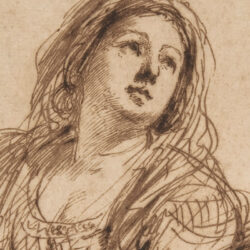From pure white to earthy red, chalk comes in a variety of natural forms. As one of the earliest mediums found in the history of art, chalk can be more durable than expected when kept safely in the correct conditions.
 Above: examples of chalk drawings, sketches and drafts from various centuries
Above: examples of chalk drawings, sketches and drafts from various centuries
Whilst the pigment may give way when it is smudged or over-handled, chalk artwork faces danger from the paper surface it is most frequently composed upon. Whether it is a modern paper or historic parchment, drawings can face a series of issues from mould to acid burns.
 Above: a detail from Head of a Woman (Allegory of America) by Antoine Vestier, late 18th / early 19th century
Above: a detail from Head of a Woman (Allegory of America) by Antoine Vestier, late 18th / early 19th century
This article will cover the use of chalk by artists over centuries, as well as the professional care and restoration of these delicate chalk drawings.
What is chalk?
Deposits of natural white chalk are a form of limestone and calcite, created from the compression of fossilised fragments, often the remains of ancient sea shells and plankton. Widespread geographical areas of white chalk throughout Europe made this an easily obtainable material for draughtsmanship.
 Above: white chalk highlights show up best on coloured paper which is why many artists chose a tan or blue background for their drawings, above are examples by Peder Severin Krøyer, Edgar Degas and Hyacinthe Rigaud
Above: white chalk highlights show up best on coloured paper which is why many artists chose a tan or blue background for their drawings, above are examples by Peder Severin Krøyer, Edgar Degas and Hyacinthe Rigaud
Red and black varieties also exist in natural forms, the popular sanguine red used by Renaissance masters is a build-up of the same extinct sea life with an infusion of clay or iron oxide. Black chalk is often a type of metamorphic rock called schist, making it appear much softer than charcoal.
 Above: red and black chalk detail from The Coral Necklace by Frederick Sandys, 1871
Above: red and black chalk detail from The Coral Necklace by Frederick Sandys, 1871
Natural chalk does not need to be processed beyond forming it into a smooth, practical shape. This sets it apart from most other mediums that require a process of careful mixing to create a stable and attractive palette.
 Above: chalk is sometimes used alongside watercolours and pastels, as seen in these sketches by John Hoppner and Anthony Devis
Above: chalk is sometimes used alongside watercolours and pastels, as seen in these sketches by John Hoppner and Anthony Devis
Trois crayons and the use of chalk in art
Although chalk is a simply prepared and easily obtainable medium, it is a well regarded form in the history of art and one of the most important. Across art history, different shades of chalk have been used to accomplish different aspects of a drawing.
 Above: three studies in red, black and white chalk by Jean Antoine Watteau, 1715
Above: three studies in red, black and white chalk by Jean Antoine Watteau, 1715
Used together, these colours form trois crayons – a famous combination that is associated with French artists such as Watteau, Fragonard and Boucher. Originating in the renaissance period and developed further by Rubens, trois crayons is a much admired form of drawing.
 Above: from left to right – Portrait of John Poyntz attributed to Hans Holbein the Younger (early 16th century), Study of a Seated Woman by Adélaïde Labille-Guiard (1789) and Study of a young girls head, hands and foot by Charles de la Fosse (17th century)
Above: from left to right – Portrait of John Poyntz attributed to Hans Holbein the Younger (early 16th century), Study of a Seated Woman by Adélaïde Labille-Guiard (1789) and Study of a young girls head, hands and foot by Charles de la Fosse (17th century)
This ability to layer three colours allowed artists to build up their drawing, creating a dynamic aspect to what might otherwise be a flat picture. To allow the white tones to show up more effectively, artists purposely used coloured paper. As chalks were often used to draft full scale paintings and sculptural work, this strongly assisted in the tonal layering of the final composition.
 Above: detail from a study for The Bathers by Renoir, 1884-5
Above: detail from a study for The Bathers by Renoir, 1884-5
In trois crayons works and unrefined sketches, white chalk typically creates the ‘heightening’ or highlights upon a drawing composed in red or black chalk. This is especially helpful for artists wanting to create an impact with light or chiaroscuro in their eventual oil painting or mural.
 Above: detail from the study of a young boy formerly attributed to Carlo Maratti, 17th century
Above: detail from the study of a young boy formerly attributed to Carlo Maratti, 17th century
Red chalk is traditionally called sanguine because of its similarity to dry blood. This naturally warm shade was a popular drafting tool from the 15th century onwards. Sanguine has a wide range of natural variations depending on the type of oxide or oche found in the geography of the region, therefore it can range from brown, beige and light tan to orange, terracotta and dark red.
 Above: red chalk studies by Parmigianino (1522), Raphael (1506-7) and Michelangelo (1510-11)
Above: red chalk studies by Parmigianino (1522), Raphael (1506-7) and Michelangelo (1510-11)
Black chalk is either used as the primary colour in a drawing or to produce areas of shadow and fine detail. Black chalk is sometimes confused with graphite or a light use of charcoal without close inspection and knowledge of the artist’s style and era.
 Above: detail from a chalk sketch by Andrea Appiani, 1811
Above: detail from a chalk sketch by Andrea Appiani, 1811
Although it is a relatively simple medium, chalk can be difficult to work with. As well as smudging, it can be difficult to correct. Prior to the invention of erasers, artists would scrape unwanted chalk off with pumice, a knife or even roll breadcrumbs on the surface.
 Above: detail from a chalk portrait of Etienne-Maurice Falconet by Jean-Baptiste Lemoyne the Younger, 1741
Above: detail from a chalk portrait of Etienne-Maurice Falconet by Jean-Baptiste Lemoyne the Younger, 1741
Handling chalk drawings
An inherent risk with chalk is that it lies on the surface of the paper. If it has not been stabilised or fixing agents have broken down due to age, the slightest movement of a powdered line could lead to a drastic smudge and severe visual disturbance. With this in mind, it is highly recommended to never touch the artwork directly and to keep the piece flat and facing upwards during movement, transport, or storage. A chalk drawing could face major damage if it is rolled or folded in any way, so this should always be avoided.
Wear gloves when handling the edges of the paper to avoid the transference of any oils from the skin or cross-contamination. If there are no clear edges to hold without touching the colours or chalks, carefully slide the paper on top of a clean and acid-free board or plain paper, to avoid any contact. During our framing process, the piece will be able to be mounted in safe conservation appropriate conditions, making it easier to handle in this scenario.
 Above a black chalk and watercolour artwork before and after restoration following mould growth and acidic decay
Above a black chalk and watercolour artwork before and after restoration following mould growth and acidic decay
Chalk should always be framed with a conservation mount to provide space between the glass and the pigments, it should also be free from static to avoid loose power being pulled onto the glazing. If a chalk drawing is framed, do not remove it from this casing or try to re-frame it yourself. It is best that a trained conservator or framing expert performs this task for you, especially if the artwork has high monetary or sentimental value.
Chalk paint restoration and conservation
Chalk can be safely restored with professional conservation techniques. Our paper conservator is able to gently clean and stabilise both the paper and the pigments without disruption to the drawing itself. Works on paper are delicate pieces, but the extra fragility of the chalk means that they are at high risk of loss if there is no intervention from a conservator following damage or decay. Below is an example of a previous result from our studio following acidic staining and natural discolouration.

Natural fixing agents were sometimes used from the 19th century onwards, but generally antique chalks have no protective layer. Today, various options are available for fixing chalk and pastel drawings in place, but these are not recommended for an attempt at home and will not be used during conservation treatment, as they can darken and disturb the artwork over time. Instead, conservation approved framing options are recommended to prevent smudges.
Paper is at high risk of mould, as their porous surface can attract moisture in a humid environment. Foxing may also occur, displaying as small rusty brown spots. To reduce this risk, a work on paper should be kept away from kitchens, bathrooms and areas with high humidity. Our paper conservator can carefully remove mould and foxing spots, clearing the visual disturbance and preventing it from taking over the artwork entirely.
 Above: a chalk and pastel drawing before and after restoration by our paper conservator
Above: a chalk and pastel drawing before and after restoration by our paper conservator
Historically, works on paper were not displayed on walls due to the vulnerability they faced without a glass barrier, they were kept out of sunlight, mounted in books or boxes. In the past, an artwork may have also been framed improperly, leading to a risk of decay from insufficient mounting or acidic materials which have been used in this process. Acid stained paper usually appears as yellow or darkened in appearance. Our paper conservator can safely remove unsafe mounts, glues or acidic staining and our team can help you to select a safe framing option with conservation-approved materials.
How can we help?
If you have any questions about art restoration and conservation, please do not hesitate to get in touch. As part of our service we offer a nationwide collection and delivery service as well as information on worldwide shipping to our studio. E-mail us via [email protected] or call 0207 112 7576 for more information.

 Above: examples of chalk drawings, sketches and drafts from various centuries
Above: examples of chalk drawings, sketches and drafts from various centuries 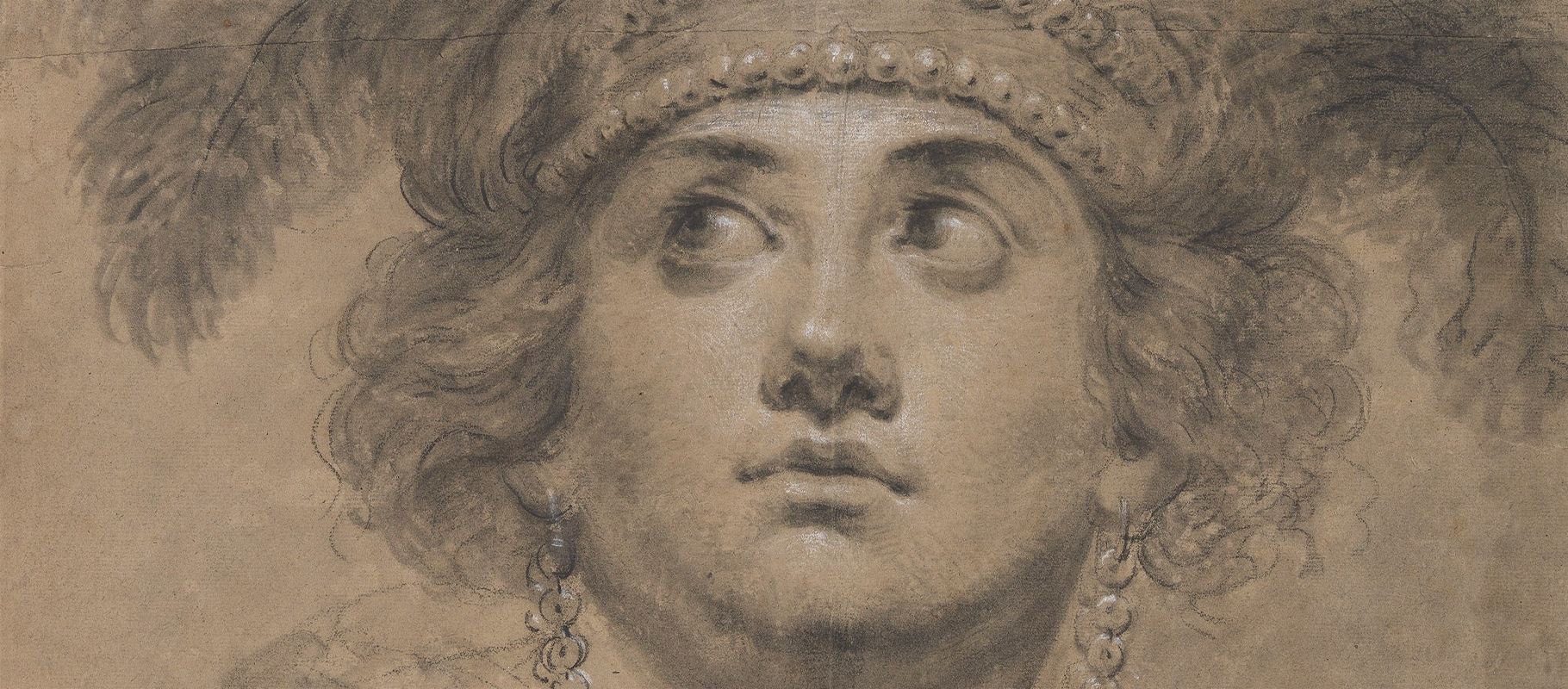 Above: a detail from Head of a Woman (Allegory of America) by Antoine Vestier, late 18th / early 19th century
Above: a detail from Head of a Woman (Allegory of America) by Antoine Vestier, late 18th / early 19th century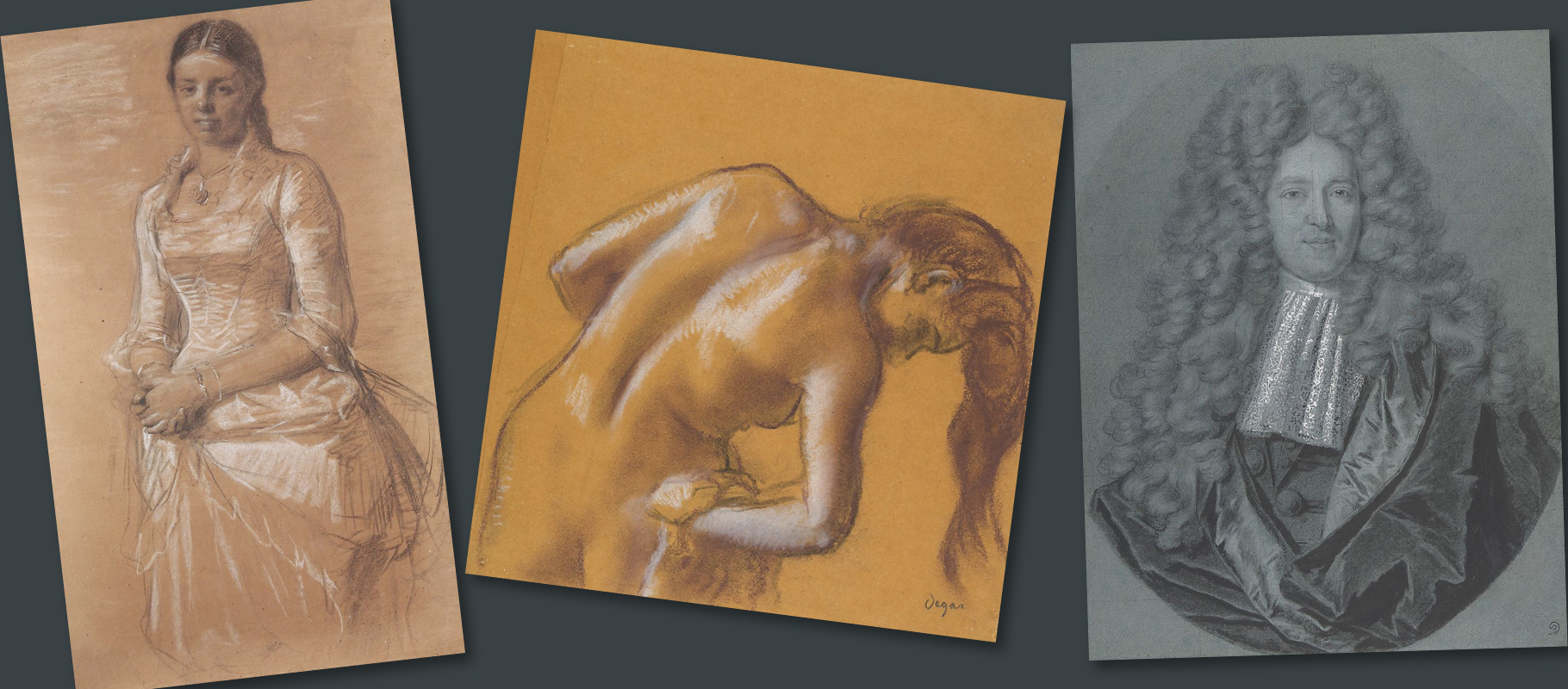 Above: white chalk highlights show up best on coloured paper which is why many artists chose a tan or blue background for their drawings, above are examples by Peder Severin Krøyer, Edgar Degas and Hyacinthe Rigaud
Above: white chalk highlights show up best on coloured paper which is why many artists chose a tan or blue background for their drawings, above are examples by Peder Severin Krøyer, Edgar Degas and Hyacinthe Rigaud Above: red and black chalk detail from The Coral Necklace by Frederick Sandys, 1871
Above: red and black chalk detail from The Coral Necklace by Frederick Sandys, 1871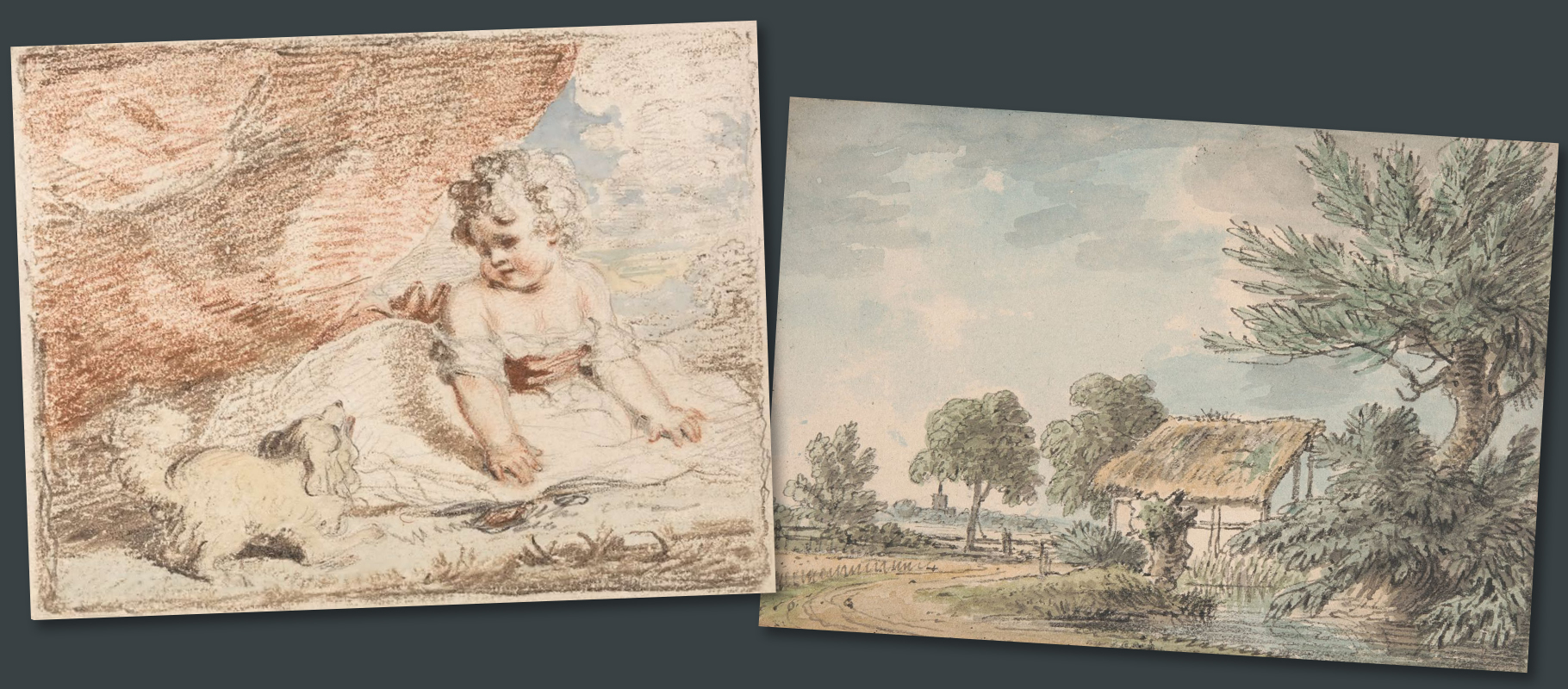 Above: chalk is sometimes used alongside watercolours and pastels, as seen in these sketches by John Hoppner and Anthony Devis
Above: chalk is sometimes used alongside watercolours and pastels, as seen in these sketches by John Hoppner and Anthony Devis Above: three studies in red, black and white chalk by Jean Antoine Watteau, 1715
Above: three studies in red, black and white chalk by Jean Antoine Watteau, 1715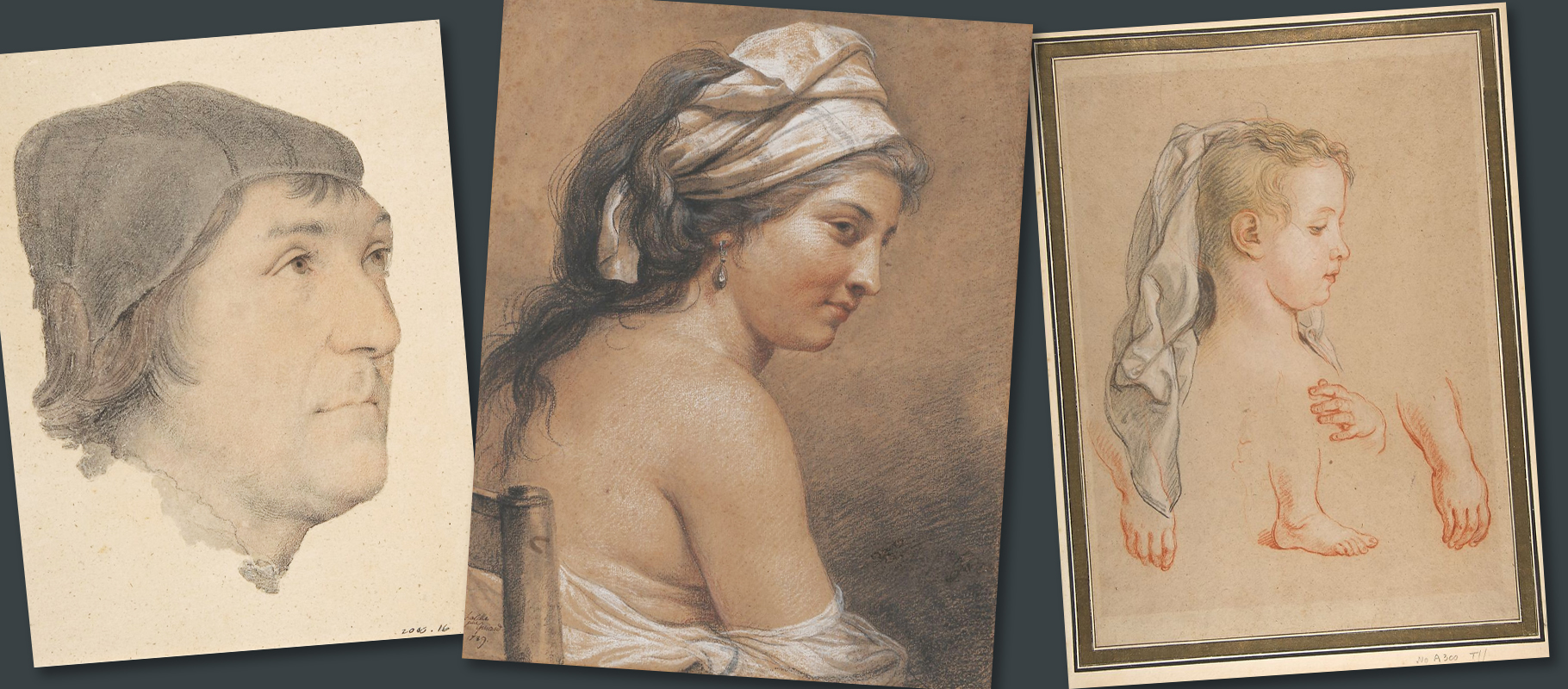 Above: from left to right – Portrait of John Poyntz attributed to Hans Holbein the Younger (early 16th century), Study of a Seated Woman by Adélaïde Labille-Guiard (1789) and Study of a young girls head, hands and foot by Charles de la Fosse (17th century)
Above: from left to right – Portrait of John Poyntz attributed to Hans Holbein the Younger (early 16th century), Study of a Seated Woman by Adélaïde Labille-Guiard (1789) and Study of a young girls head, hands and foot by Charles de la Fosse (17th century)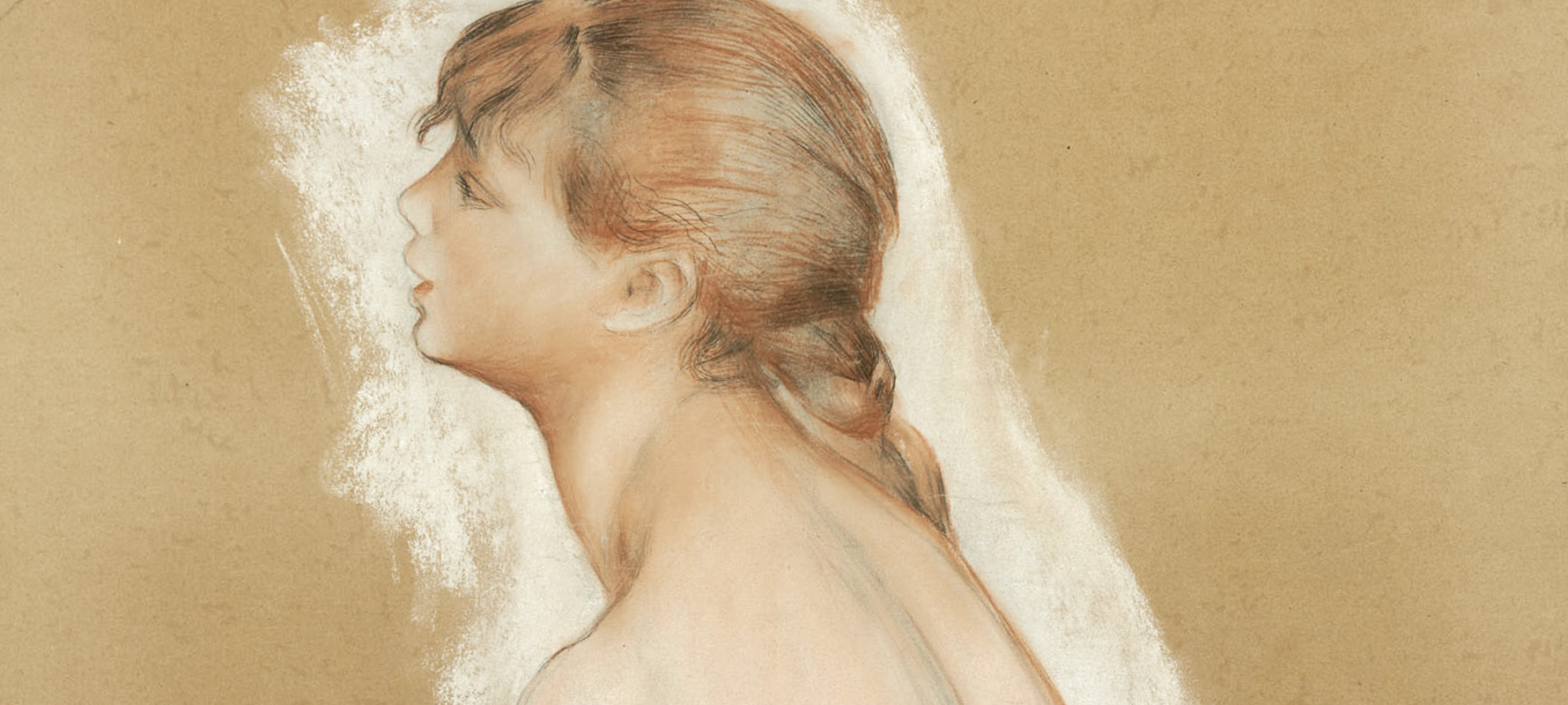 Above: detail from a study for The Bathers by Renoir, 1884-5
Above: detail from a study for The Bathers by Renoir, 1884-5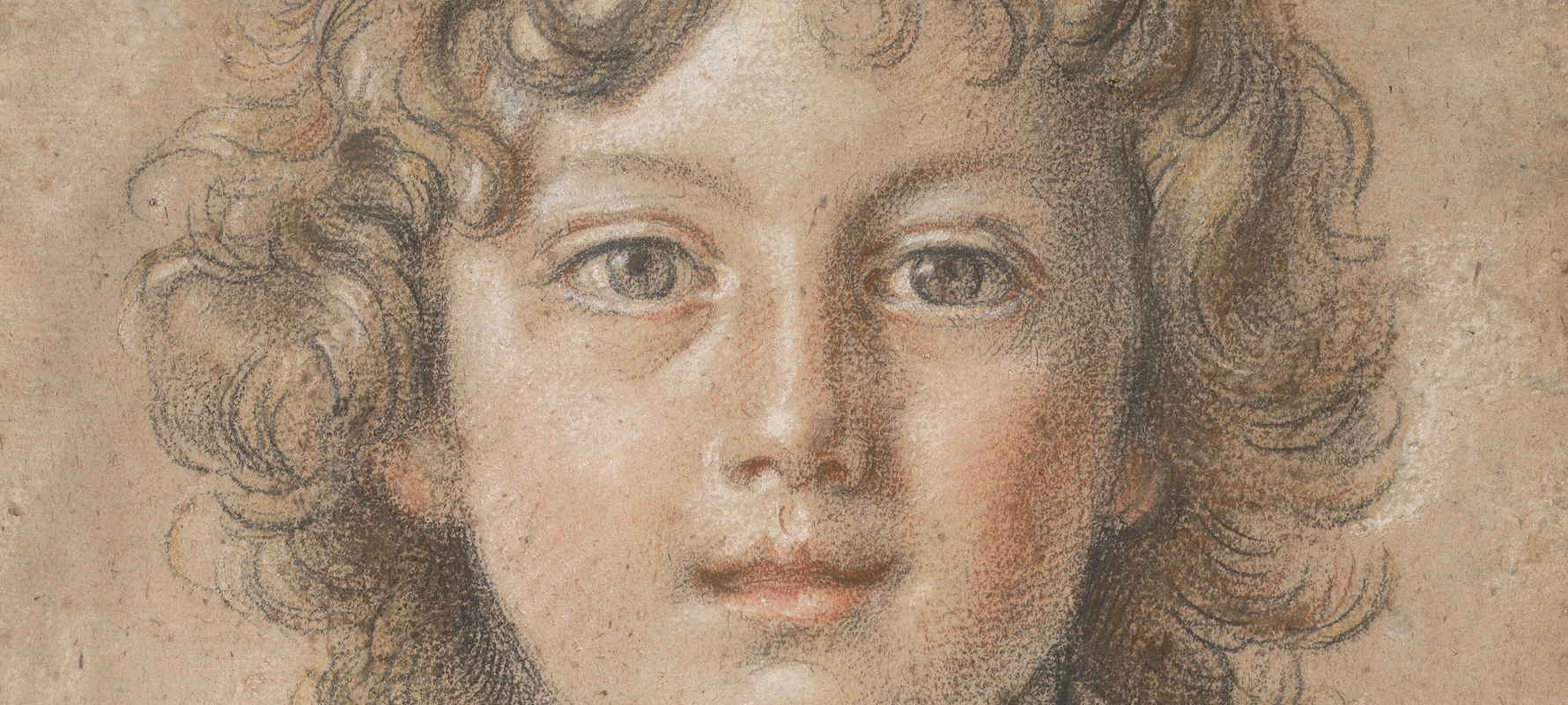 Above: detail from the study of a young boy formerly attributed to Carlo Maratti, 17th century
Above: detail from the study of a young boy formerly attributed to Carlo Maratti, 17th century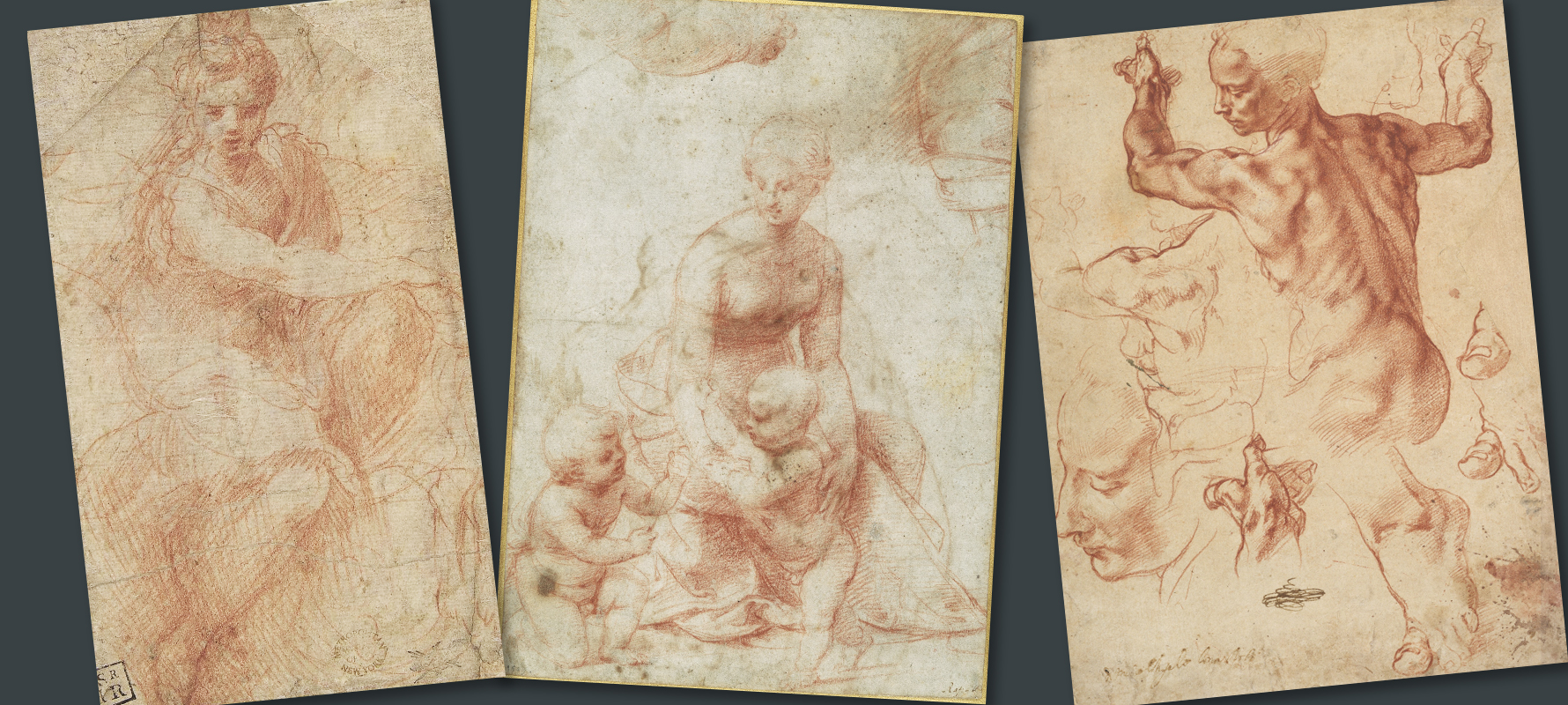 Above: red chalk studies by Parmigianino (1522), Raphael (1506-7) and Michelangelo (1510-11)
Above: red chalk studies by Parmigianino (1522), Raphael (1506-7) and Michelangelo (1510-11)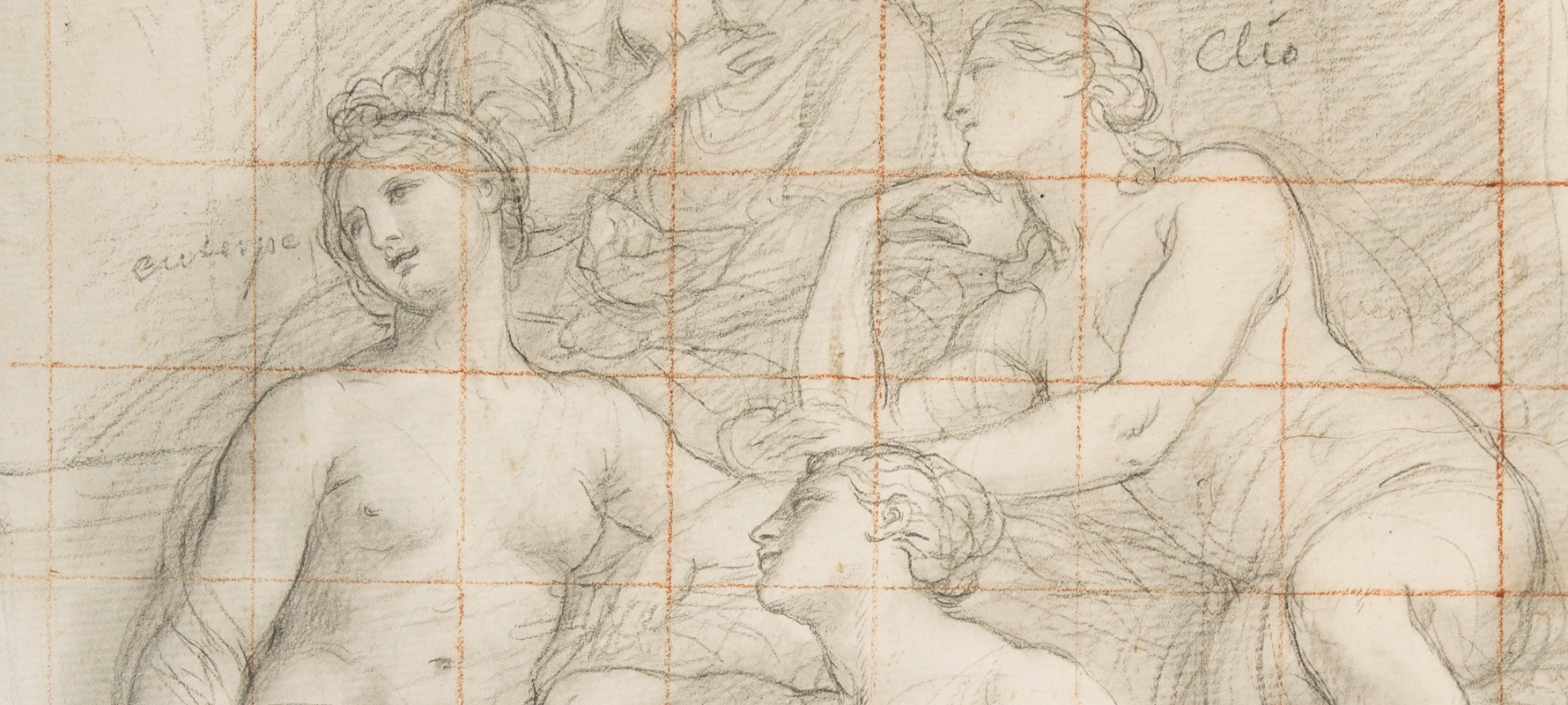 Above: detail from a chalk sketch by Andrea Appiani, 1811
Above: detail from a chalk sketch by Andrea Appiani, 1811 Above: detail from a chalk portrait of Etienne-Maurice Falconet by Jean-Baptiste Lemoyne the Younger, 1741
Above: detail from a chalk portrait of Etienne-Maurice Falconet by Jean-Baptiste Lemoyne the Younger, 1741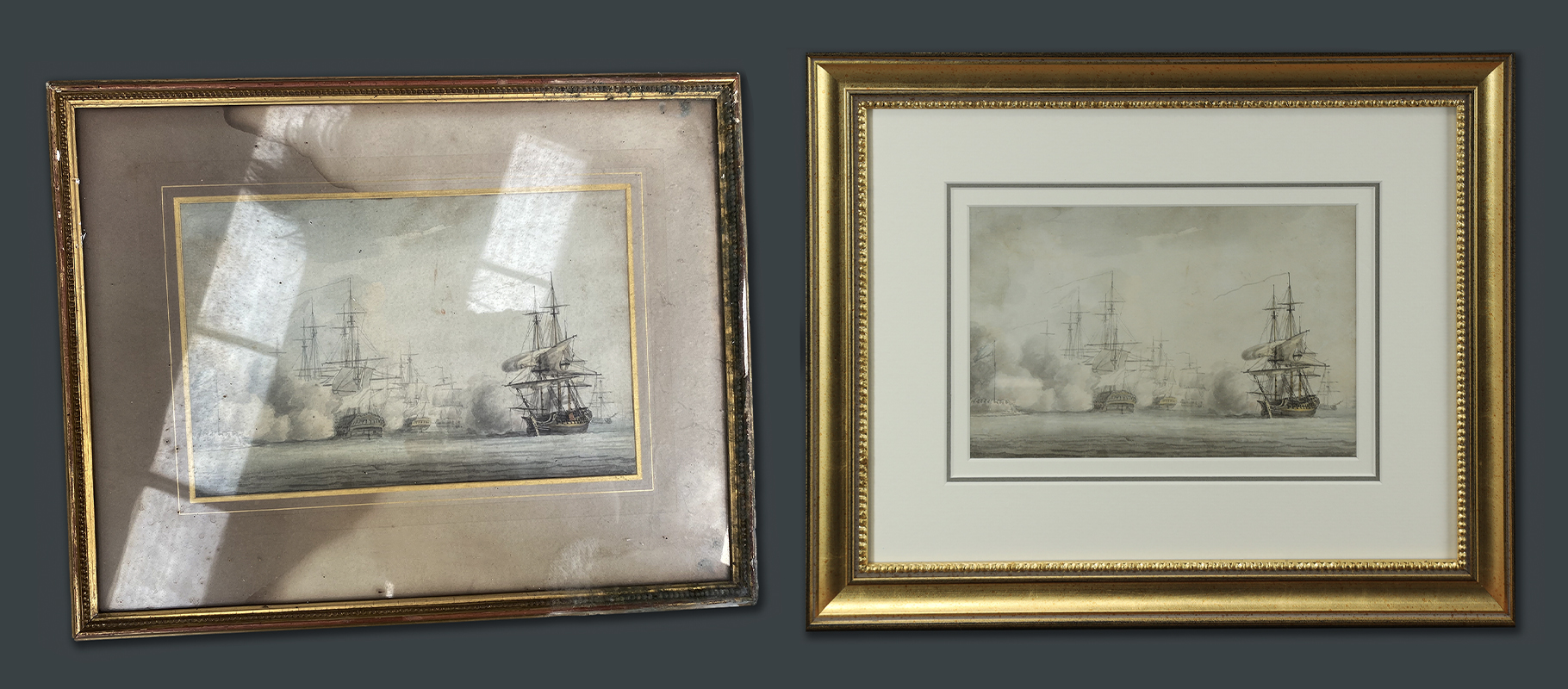 Above a black chalk and watercolour artwork before and after restoration following mould growth and acidic decay
Above a black chalk and watercolour artwork before and after restoration following mould growth and acidic decay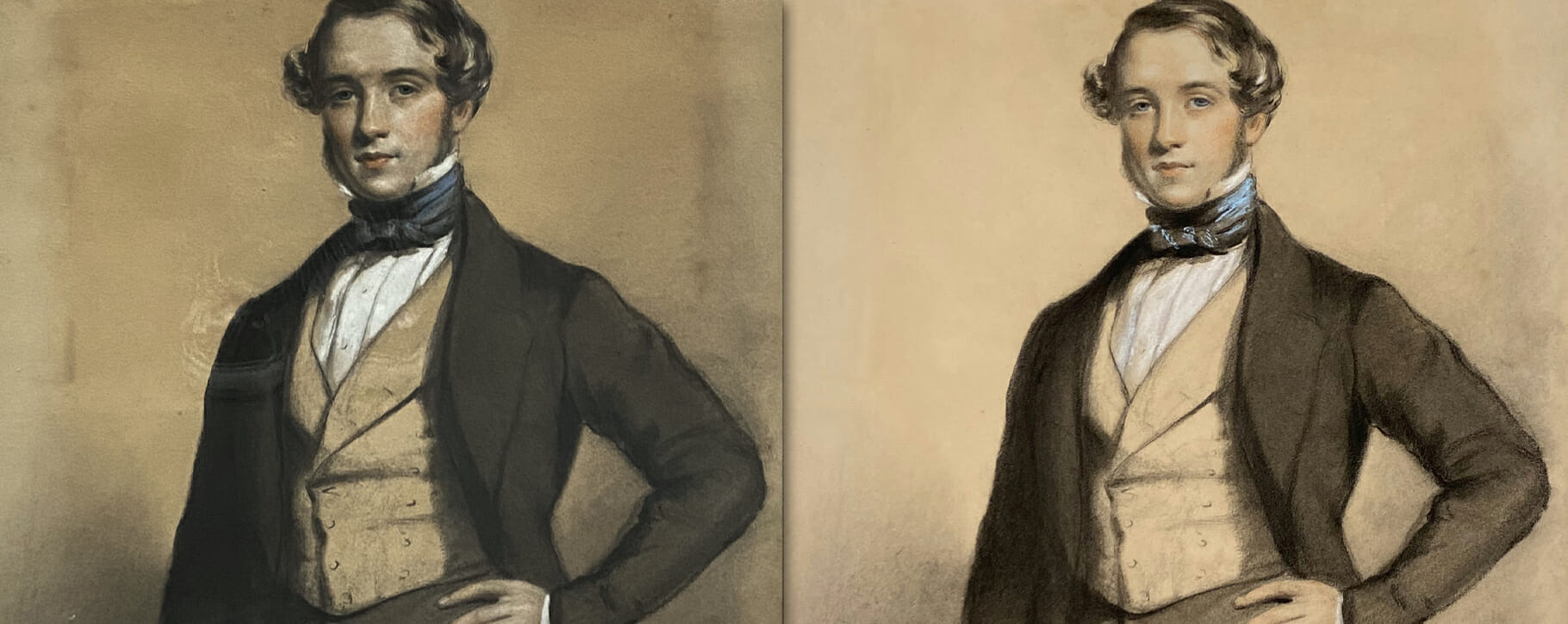 Above: a chalk and pastel drawing before and after restoration by our paper conservator
Above: a chalk and pastel drawing before and after restoration by our paper conservator




